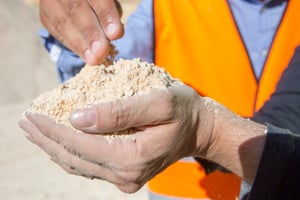With the Grand Paris Express, the capital of France and its neighbourhood are getting a new metro with 68 new stations and 200 kilometres of additional tracks. The automated transit network will be the largest in Europe used by two million commuters each day.
The team of Bouygues Construction is carrying out research in close collaboration with the experts of Master Builders Solutions to use MasterSuna SBS for the project: The new concrete admixture facilitates the utilization of sand grades which were previously unsuitable to produce everyday concrete.
Given the backdrop of depleting resources such as sand and the saturation of landfills in Île-de-France, and due to the volumes excavated for this work, the idea of reusing the land excavated for new construction was very appealing. Laure Abdul, PhD in Materials Engineering, leads a research project concerning the concept of soil-cement which is being carried out within the Materials Engineering Division, a Bouygues Construction/Bouygues Travaux Publics centre of excellence. This project aims to reuse excavated soil as sand for concrete. In our interview, he explains how this works.
Could you explain to us how this project was conceived?
In the context of Bouygues Construction’s partnership with Master Builders Solutions, we began by studying the changes in the soil extracted during tunnelling. This soil receives a special chemical conditioning agent, such as injected foam for example, which is necessary for the progress of the tunnel boring machine. In order to properly select these products, we had to understand the changes they brought about in the properties of the excavated soil, both in the short and long term. After a period of several days, no significant impact was found on the soil. In early 2016, with the Grand Paris (Greater Paris) project approaching, we then reflected on how we could reuse this excavated soil, commonly known as spoil. Given the backdrop of depleting resources such as sand and the saturation of landfills in Île-de-France, and due to the volumes excavated for this work, the idea of reusing the land excavated for new construction was very appealing.
For about two years now, the Materials Engineering Division has been conducting research to remove any barriers and allow the reuse of excavated spoil in concrete. What exactly is it?

It is critical to understand that there are several types of excavated soil and in particular several types of sand. For standard sand, whether it has received a conditioning agent or not, reuse does not pose any particular problem because the performance is not impacted. On the other hand, in Île-de-France, Beauchamp sand is widely present, particularly where the work concerning line 14 is located and in the north. This sand has the distinctive feature of being loaded with clay, which makes it very absorbent and can have a real impact on its properties. The conditioning agent is not the problem, it’s the clay content.
In 2017, we realized that Colas was using a concrete admixture for clay, called MasterSuna, manufactured by our partner Master Builders Solutions to treat the crushed sand from some of their quarries. We then began to research if we could use it on the Beauchamp sand to allow us to manufacture concrete with favorable properties.
Two experimental campaigns are being conducted this year with the aim of defining the optimum amount of the additive to use depending on the amount of clay present. The consistency of the fresh concrete is tested to verify that it allows the implementation on site 90 minutes after production. The condition of the hardened concrete is also tested to measure mechanical properties, as well as dimensional variations, durability and hardness. Accelerated testing exists and lasts about three months. Final trials to check the mechanical and rheological properties of concrete made with spoil (excavated soil from tunnel boring machines) as a raw material are already ongoing.
In addition to this research on the material itself, have you encountered other problems related to the deployment of soil cement?
In addition to the properties of the material itself, site logistics is also important because there is a real problem concerning storage. In the Paris region, construction sites have little room for storage nearby. This sand could be used on the construction sites of nearby stations, or it could be used for items that are prefabricated in a factory and which will then be brought to other building sites. It’s all about saving resources.
Investigating the different ways to optimize the use of soil cement is one of the next steps in the project. Our participation in the innovation competition was also intended to publish the project within the group, with the aim of welcoming new partners and new skills focused on logistics, for example.
Thank you, Laure Abdul, for your valuable insights.
Discover more about MasterSuna SBS here.


/in%20USE/partner_Master_Builders_Solutions_service_customer_benefits.jpg)